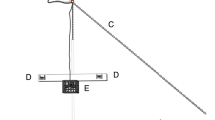Abstract
We have studied the behavioral responses of fishing spiders (Dolomedes triton and Dolomedes okefinokensis) to water surface wave stimuli. D.okefinokensis responded to click-like wave stimuli (Fig. 3C) in less than 15% of the cases. Responsiveness did not increase if up to 20 clicks were elicited in quick succession from the same spot (Fig. 5). If longer lasting concentric stimuli were offered, the spiders determined the direction (Fig. 6) and the distance (Fig. 8) to the wave source. This was true for monofrequency stimuli and for narrow-band and broadband noise stimuli. If concentric multifrequency surface waves were offered, even a fivefold decrease in stimulus amplitude did not significantly change the mean running distance of D.triton. However, if multifrequency wave stimuli with a flat wave front were presented, the spiders (D.triton) no longer determined the source distance precisely (Figs. 11, 12). Our results indicate that fishing spiders of the genus Dolomedes mainly use the curvature of a concentric wave stimulus for distance determination.
Similar content being viewed by others
References
Barnes WJP, Barth FG (1991) Sensory control of locomotor mode in semi-aquatic spiders. In: Armstrong DM, Bush BMH (eds) Locomotor neural mechanisms in arthropods and vertebrates. Manchester Univ Press, Manchester NY, pp 105–116
Barth FG, Bohnenberger J (1978) Lyriform slit sense organ: thresholds and stimulus amplitude ranges in a multi-unit mechanoreceptor. J Comp Physiol 125:37–43
Baurecht D, Barth FG (1992) Vibratory communication in spiders. I. Representation of male courtship signals by female vibration receptor. J Comp Physiol A 171:231–243
Bleckmann H (1985) Discrimination between prey and non-prey wave signals in the fishing spider Dolomedes triton (Pisauridae). In: Kalmring K, Elsner N (eds) Acoustic and vibrational communication in insects. Parey, Berlin, pp 215–222
Bleckmann H (1988) Prey identification and prey localization in surface-feeding fish and fishing spiders. In: Atema J, Fay RR, Popper AN, Tavolga WN (eds) Sensory biology of aquatic animals. Springer, Berlin Heidelberg New York, pp 619–641
Bleckmann H, Barth FG (1984) Sensory ecology of a semi-aquatic spider. II. The release of predatory behavior by water surface waves. Behav Ecol Sociobiol 14:303–312
Bleckmann H, Bender M (1987) Water surface waves generated by the male pisaurid spider Dolomedes triton during courtship behavior. J Arachnol 15:363–369
Bleckmann H, Lotz T (1987) The vertebrate-catching behaviour of the fishing spider Dolomedes triton (Araneae, Pisauridae). Anim Behav 35:641–651
Bleckmann H, Schwartz E (1982) The functional significance of frequency modulation within a wave train for prey localization in the surface-feeding fish Aplocheilus lineatus. J Comp Physiol 145:331–339
Bleckmann H, Tittel G, Blübaum-Gronau E (1989) The lateral line system of surface-feeding fish: anatomy, physiology, and behavior. In: Coombs S, Görner P, Münz H (eds) The mechanosensory lateral line. Neurobiology and evolution. Springer, Berlin Heidelberg New York, pp 501–526
Bohnenberger J (1981) Matched transfer characteristics of single units in a compound slit sense organ. J Comp Physiol 142:391–402
Carico JE (1973) The nearctic species of the genus Dolomedes (Araneae: Pisauridae). Bull Mus Comp Zool 144:435–488
Elepfandt A (1982) Accuracy of taxis response to water waves in the clawed toad (Xenopus laevis Daudin) with intact or with lesioned lateral line system. J Comp Physiol 148:535–545
Görner P, Möller P, Weber W (1984) Lateral-line input and Stimulus localization in the African clawed toad Xenopus sp. J Exp Biol 108:315–328
Hergenröder R, Barth FG (1983) Vibratory signals and spider behavior: How do the sensory inputs from the eight legs interact in orientation? J Comp Physiol 152:361–371
Hoin-Radkovski I, Bleckmann H, Schwartz E (1984) Determination of source distance in the surface-feeding fish Pantodon buchholzi (Pantodontidae). Anim Behav 32:840–851
Käse R, Bleckmann H (1987) Prey localization by surface wave-ray tracing fish track bugs like oceanographers track storm. Experientia 43:290–293
Klärner D, Barth FG (1982) Vibratory signals and prey capture in orb-weaving spiders (Zygiella x-notata, Nephila clavipes; Araneidae). J Comp Physiol 148:445–455
Lang HH (1980) Surface wave discrimination between prey and nonprey by the back swimmer Notonecta glauca L. (Hemiptera, Heteroptera). Behav Ecol Sociobiol 6:233–246
Machlis L, Dodd PWD, Fentress JC (1985) The pooling fallacy: Problems arising when individuals contribute more than one observation to the data set. Z Tierpsychol 68:201–214
Markl H, Lang HH, Wiese K (1973) Die Genauigkeit der Ortung eines Wellenzentrums durch den Rückenschwimmer Notonecta glauca. J Comp Physiol 86:359–364
Müller U, Schwartz E (1982) Influence of single neuromasts on prey-localizing behavior of surface-feeding fish Aplocheilus lineatus. J Comp Physiol 149:399–408
Palmgren P (1939) Ökologische und physiologische Untersuchungen über die Spinne Dolomedes fimbriatus (Cl.). Acta Zool Fennica 24:1–42
Reinig HJ, Uhlemann H (1973) Über das Ortungsvermögen des Taumelkäfers Gyrinus substriatus (Coleoptera, Gyrinidae). J Comp Physiol 84:281–298
Rudolph P (1967) Zum Ortungsverfahren von Gyrinus substriatus Steph. Z Vergl Physiol 56:341–375
Schmidt G (1952) Eine deutsche Spinne, die Wirbeltiere frißt. AquarienTerrarienzeitschrift 10:269–272
Schmidt G (1957) Einige Notizen über Dolomedes fimbriatus (Cl.). Zool Anz 158:83–97
Schwartz E (1965) Bau und Funktion der Seitenlinie des Streifenhechtlings (Aplocheilus lineatus Cuv. u. Val.). Z Vergl Physiol 50:55–87
Seyfarth EA, Pflüger HJ (1984) Proprioceptor distribution and control of a muscle reflex in the tibia of spider legs. J Neurobiol 15:365–374
Sommerfeld A (1970) Vorlesungen über theoretische Physik. Bd. 2: Mechanik der deformierbaren Medien. Akad Verl Ges, Leipzig, pp 1–446
Speck-Hergenröder J, Barth FG (1988) Vibration sensitive hairs on the spider leg. Experientia 44:13–14
Wiese K (1974) The mechanoreceptive system of prey localization in Notonecta. II. The principle of prey localization. J Comp Physiol 92:317–325
Williams DS (1979) The feeding behavior of New Zealand Dolomedes species (Araneae: Pisauridae). New Zealand J Zool 6:95–105
Zimmermann M, Spence JR (1989) Prey use of the fishing spider Dolomedes triton (Pisauridae, Araneae): an important predator of the neusten community. Oecologia 80:187–194
Author information
Authors and Affiliations
Rights and permissions
About this article
Cite this article
Bleckmann, H., Borchardt, M., Horn, P. et al. Stimulus discrimination and wave source localization in fishing spiders (Dolomedes triton and D. okefinokensis). J Comp Physiol A 174, 305–316 (1994). https://doi.org/10.1007/BF00240213
Accepted:
Issue Date:
DOI: https://doi.org/10.1007/BF00240213




